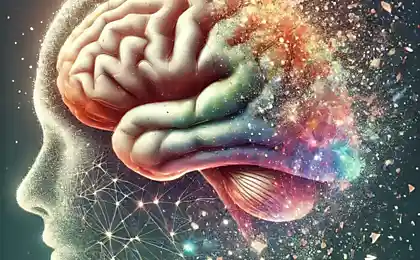323
How to Feed a Programmer’s Brain... or Everyone Needs to Know

Of all the pleasures given to man in life,
The most exquisite thing is to move your brain.
© Boris Akunin
It is known that when working at a computer, the brain of a programmer spends more energy than the brain of other people. A programmer, as a knowledge worker, must monitor his diet and health to keep his brain in a state of high performance. In addition, the programmer should be in excellent intellectual form, develop high creative activity and think about preventing age-related memory impairment.
In my early youth, when I was diving deep into a project, I often forgot about food, and it used to be that my only food for the day was a kefir bar. Now, over the years, I understand how I traumatized my brain without giving it the substances and energy it needs to work.
In this publication, we will look at how to eat properly for the life support of the brain and how to disperse it with nootropics (in the case of auralanenenenenenepossibility).
So, 26% of the energy of the main metabolism is spent on maintaining muscle tone, 25% on the functioning of the liver, about 18% on the activity of the brain.
The brain can be improved in several ways:
improving the conduction of nerve impulses (synaptic transmissions) by providing a sufficient number of neurotransmitters (substances that carry out impulse transmission from the nerve cell);
improve blood supply to the brain, normalize blood pressure;
Supporting brain nutrition (providing energy, especially glucose)
Control of hormonal levels (especially hormones of “happiness”).
Sea fish (especially salmon, tuna, herring)
It contains the highest amount of omega-3 fatty acids. Phosphorus is also important for the brain.
Spinach, broccoli and legumes
Sources of folic acid and beta-carotenes, which helps to improve cognitive abilities
Walnut
Omega-3 acids, vitamins B2, B12, E
Milk and dairy products
Vitamin B, calcium, phosphorus
Chicken eggs
A valuable source of iron, iodine, omega-3 fatty acids and vitamin B12. It also contains choline (a neurotransmitter that increases brain performance).
Cheese
Contains a lot of tryptophan (produces serotonin)
Black chocolate
A set of bioflavonoid antioxidants, the hormone phenylethylamine, which elevates mood and enhances mental clarity. Excellent stimulation of the brain and enhancement of human cognitive abilities. Avoid sweetened dark chocolate! The norm of chocolate is 50 – 200 grams during the day.
Carrots
It contains luteolin. Helps reduce age-related memory deficits and inflammation in the brain
Oatmeal
Zinc and vitamins E and group B
Blueberries and strawberries
Flavonoids - anthocyanidins and polyphenols protect brain cells from aging
Green tea
Maintains water-salt balance in the body, including in brain cells, increasing metabolism and improving memory.
Pumpkin seeds
Contains a lot of tryptophan (produces serotonin)
Tomatoes
The source of lycopene is the protection of brain cells from destructive effects.
Beets
Group B vitamins
Apples
They contain catechins – substances that protect brain cells from harmful chemicals.
Let’s look at some of the ways to achieve all of this.
Corrective nutrition
Scientists say that for normal brain function, it is necessary to regularly eat foods high in antioxidants, omega-3 fatty acids and B vitamins.
In this table, in descending order of effects on the brain, the most significant products are listed.
Multivitamins
For those who are not able to replenish the necessary set of microelements with a diet, there are combined multivitamin preparations, such as Balansin, Gotu Kola, Doppelhertz Activ, Intelamin, Memori Rice, Memostrong, NeuroBright, Secretag. Let me remind you that all these drugs are not medicines and are registered as dietary supplements. Also, almost all of them are Western-made and have a high price.
Additives
DMAE (Dimethylaminoethanol)
It stimulates brain function, enhances memory, concentration, creative abilities and improves mood. Significantly increases the energy status of the body, in connection with which it is widely used by athletes. Significantly improves the properties of blood. DMAE helps remove cellular debris (lipofuscin). The downside is a high price.
creatine
It is an acid involved in the energy metabolism of nerve cells. Creatine is a very effective tool for improving memory and attention stability. The norm is from 5000 mg per day.
Caffeine + L-Theanine
Caffeine alone does not significantly improve mental abilities. However, the combination of caffeine and L-Theanine, an amino acid found in green tea leaves, does have the potential to create long-term benefits, including improved working memory, faster processing of visual information, and especially shifting attention. It is optimal to take 50 mg of caffeine (about a cup of coffee) and 100 mg of L-Theanine (a cup of green tea contains only about 5-8 mg of this substance).
Herbal remedies
bacopa
It has properties to improve memory and cognitive abilities. The optimal daily intake of 150 mg of the supplement is considered.
Ginkgo biloba
This supplement is obtained from the leaves of the rarest tree Ginko biloba. It improves memory and concentration. Dosage at 240-360 mg per day.
ginseng
Helps improve working memory, concentration, has a beneficial effect on mood. Take 500 mg twice a day.
Rhodiola pink
Promotes the production of dopamine and serotonin, which naturally affects mood. It is recommended to take 100-1000 mg, which should be divided into two equal parts.
Spanish sage
Contains acetylcholine, responsible for the speed of thought processes. The dosage is 300 mg in dry leaves once a day.
Let's go over the food again.
Every day we have to eat:
"slow" carbohydrates that are gradually absorbed without causing a sharp rise in blood glucose levels. They're better for breakfast. Then for a long time creates a feeling of satiety, good mood, the brain is supplied with glucose, which is used to generate energy;
sufficient amount of vitamins of group B (B1, B2, B3, B5, B6, B12);
vitamin C (the main water-soluble antioxidant and catalyst for many processes);
Magnesium is the main anti-stress mineral that protects against insomnia, fatigue, nervousness, mood swings, necessary for active mental and physical activity;
omega-3 polyunsaturated fatty acids (PUFAs), which are included in the membranes of neurons and improve the conduction of nerve impulses, as they stimulate the synthesis, secretion and activity of neurotransmitters;
dimethylaminoethanol (DMAE), which enhances the synthesis of the neurotransmitter acetylcholine and exhibits pronounced antioxidant properties;
highly digestible iron. It is with the lack of iron that loss of physical strength and endurance, deterioration of learning ability, increased fatigue are often associated;
organic iodine. With its lack, the production of thyroid hormones is suppressed and the ability of the brain to produce energy sharply decreases;
proteins rich in amino acids. Thus, the amino acid tyrosine is a precursor of norepinephrine, adrenaline and dopamine (responsible for energy production); tryptophan-serotonin (the hormone of happiness) and melatonin (the sleep hormone).
Derivatives of pyrrolidone (racetams)
Piracetam, aniracetam, pramiracetam, oxiracetam, etiracetam, nefiracetam, phenotropil.
Drugs that enhance cholinergic processes
Ipidacrine, amiridine, tacrine, gliatyline
GABA-ergic drugs
Gamma-aminobutyric acid, pantogam, picamilon, phenibut, sodium oxybutyrate
Glutamatic drugs
Glycine, memantine
Neuropeptides and their analogues
Semax, cerebrolysin
Antioxidants and membrane protectors
Meclophenoxate, mexidol, pyritinol
Ginkgo biloba drugs
Bilobil, tanakan, memoplant
Calcium channel blockers
Nimodipine, cinnarizine
Cerebral vasodilators
Vinpocetine, nicergoline, instenone
Hormones - the main neurotransmitters
Serotonin is one of the most important neurotransmitters known to influence mood so strongly that it is sometimes called the “pleasure hormone.” Serotonin itself is produced by the body from the amino acid tryptophan. Thus, by consuming more tryptophan foods, we add ourselves the pleasure hormone. As tryptophan decreases, you need to consume cheese, meat, fish and peas.
Oxytocin is a complex hormone associated with satisfaction and sex. It is released into the blood when a person enjoys communication. Oxytocin causes feelings of satisfaction, decreased anxiety, and a sense of calm. Intimacy, caresses, pleasant communication - all this contributes to its development. A lack of oxytocin leads to sociopathy.
Dopamine is the hormone of joy. It imparts confidence, purposefulness and benevolence, and helps adapt. Indecision and shyness are usually a manifestation of dopamine deficiency. Dopamine causes a sense of satisfaction, affects motivation and the learning process. It is developed during sex, taking delicious food, pleasant bodily sensations, memories of something pleasant. Dopamine production is affected by drugs, nicotine and alcohol.
Endorphin ("the hormone of joy"). The chemical structure is similar to opiates. They are produced by the body in the neurons of the brain and affect the emotional state. The safest and most effective way to develop endorphins is sports.
Thyroxine (“energy hormone”) is produced by the thyroid gland. It affects metabolism, slimness, appetite, energy, activity, efficiency, cheerfulness. For the health of the thyroid gland and the production of thyroxine, iodine-containing products should be used: walnuts, algae, seaweed.
Medicinal methods of brain spinning
Perhaps we should only talk about nootropics. Nootropics are used in disorders of cerebral circulation, sleep deprivation, fatigue, asthenic and depressive states after traumatic brain injuries and neuroinfections. Nootropics are also good because they are suitable for both treatment and prevention in order to improve mental performance. In general, nootropic drugs are characterized by relatively low toxicity and a minimum of side effects.
Nootropization is the most effective modern method of “rocking” the brain and is recommended for use only in special periods – exam, deadline, interview.
Nootropics enhance the supply of blood to the brain, which means glucose and oxygen, improve the “communication” between each other as individual brain cells, as well as individual parts and hemispheres. As a result, memory, concentration, intelligence, etc. improve.
An important feature of nootropics is their ability to improve the activity of the hypothalamus, which is called the conductor of the entire hormonal system.
Classification of drugs with nootropic action (Voronina and Seredenin)
Racetamas
One of the most famous drugs of this group of nootropics is piracetam.
It is one of the first nootropic drugs. It is shown, first of all, with any disorders in the brain.
Piracetam preparations - nootropil, phenotropil, it is desirable to take a course with cinarizin (improves the blood supply to the brain, thereby enhancing the effect of nootropics).
phenotropil
At the moment, it is considered the most powerful permitted nootropic in Russia. Phenotropil is a powerful neurometabolic with psychostimulating activity. I personally use it on business trips when you need active conversations in English. I feel the difference. In particular, there is an increase in mental and physical performance, as well as a noticeable decrease in fatigue and drowsiness. Naturally, for the best effect with phenotropil, you need to use B vitamins and something from vasodilators together. From side effects can be an increase in the threshold of alcoholic intoxication.
The most unpleasant factor in the use of Phenotropil is its high price of about 900 rubles for 30 tablets.
Enhancers of cholinergic processes
Drugs of this group directly stimulate excitation in nerve fibers and synaptic transmission in the neuromuscular endings.
GABA-ergic drugs
All drugs are derivatives of gamma-aminobutyric acid (GABA). This acid is one of the most important neurotransmitters in the CNS. GABA drugs cause an increase in energy processes in the brain. They are also among the most popular and cheapest of the nootropics. GABA is very well tolerated and has minimal side effects.
The most famous drugs based on GABA are aminalone, gammalon, picamilon, pantogam (gopanthenic acid), pantocalcin.
Separately, it is worth mentioning a very effective drug - phenibut, developed in the USSR, which was even included in the astronaut's first aid kit.
Glutamatic drugs
The glutamatic system is the part of the brain that is responsible for learning and memory functions. In this group is the cult glycine. It is well tolerated and practically free of side effects.
Neuropeptides
Semax is popular in this group. This is a serious drug that has a multifactorial neuroprotective effect. No side effects.
Cerebrolysin is a complex of neuropeptides and trace elements derived from the brain of young pigs. For more than 20 years, it has been used as a neuroprotector and nootropic. The drug increases the intensity of energy metabolism, synthesis of proteins in the brain, improves cerebral blood flow. It causes a noticeable effect on the brain during the day. Work capacity is increasing dramatically. Pricks courses for 10 days. The disadvantage is a very powerful tool, more than once every six months it is impossible.
Antioxidants and membrane protectors
Mexidol has pronounced nootropic and neuroprotective activity. Increases the intensity of cerebral blood flow.
Pyritinol (pyriditol, encephabol) exhibits pronounced nootropic properties in combination with antidepressant and sedative action, being a low-toxic drug.
Ginkgo biloba drugs
Standardized extracts of the relic plant Ginkgo biloba (bilobil, memoplant, tanakan, etc.) contain a composition of flavonoids. These drugs have a complex of valuable pharmacological properties, providing an antioxidant effect, enhancing energy metabolism in the brain, improving the rheological properties of blood and microcirculation.
Calcium channel blockers
By affecting the intracellular concentration of calcium, it is possible to significantly improve cerebral blood flow. Some of the best are nimodipine and cinnarizine.
Cinnarizine (stugerone) is a popular drug that improves cerebral circulation and has nootropic properties.
Cerebral vasodilators
Drugs of this group expand the capillaries of the brain.
The most famous is Cavinton (Vinpocetine).
Cavinton and his analogues have shown themselves to be quite effective in treating thinking disorders associated with brain circulation defects in the elderly, for example, due to atherosclerosis. It is recommended to take in combination with nootropics. Vinpocetine (cavinton), obtained from a small pervinc, has been used for about 30 years. It causes almost no side effects.
Instenone, which is a combination of three components - hexobendine, etamivan and ethophylline, has recently attracted attention not only as a corrector of cerebral circulation, but also as a drug with proper nootropic properties.
Prohibited drugs in Russia
Modafinil is an analeptic. Banned in Russia. More used as a psychostimulant to suppress drowsiness. The action is based on reducing one of the mechanisms of dopamine reuptake. It has no side effects and is not addictive. It is, along with Ritalin, one of the strongest smart drags.
Ritalin is a psychostimulant, but has a powerful nootropic effect. In the US, children are fed this drug from the age of 12. At the end of the action, like any psychostimulant, causes severe fatigue, depression and irritation. It causes psychological dependence.
Energy for neurons
Another useful addition to true nootropics are compounds that increase the “energy” of neurons.
The human brain is very demanding to receive energy and absorbs up to 50% of all oxygen expended by the body, using for its needs about 20% of the total energy production of the body.
Under physiological conditions, without fasting, the brain uses one single type of “fuel” – glucose. Thus, sugar is not just a source of energy for the functioning of neurons, but also a kind of weak “semi-nootropic”.
Also increases the energy of neurons L-acetylcarnitine and nicotinamide (vitamin PP).
A few simple tips to improve brain function
1. Solve puzzles and puzzles.
2. Pay attention to uncertainty and ambiguity. Learn to love paradoxes and optical illusions.
3. Develop creative thinking.
4. Transpose reality. Always ask yourself, “What if?” . . ?
5. Learn logic. Solve logical problems.
6. Play sports.
7. Observe posture.
8. Listen to classical music.
9. Get rid of procrastination (eternal postponement for later).
10. Play chess, checkers, backgammon...
11. Develop a sense of humor. Make up your jokes.
12. Develop observation.
13. Learn a foreign language.
14. Say the long words backwards.
15. Learn to play a musical instrument.
16. Try to mentally evaluate the passage of time.
17. Perform arithmetic calculations in your mind.
18. Don't watch TV. He's slowing down.
19. Put yourself in someone else's place. Imagine how other people would solve your problems.
20. Take time for solitude and rest.
21. Make a commitment to constantly learning something new.
22. Take a trip abroad. Learn about different lifestyles.
23. Talk to those who are close to you.
24. Read the classics.
25. Develop self-awareness.
26. Do introspection (analyze your actions and actions)
26. Don't be nervous.
Finally, a little physiology.
Sleep. To fully restore brain function, it is enough to sleep at least 7 hours. Don’t assume that chronic sleep deprivation can be compensated for by increased sleep time on weekends. Studies in humans have shown that attention spans and other cognitive functions cannot fully recover even after three days of a full night’s sleep, raising questions about the severity of brain disorders.
Sport. At least 30 minutes each day or replace with a walk - from 1 hour or more. Sport contributes to the production of endorphin. Endorphins are an essential component of happiness.
Alcohol. A prominent Soviet theoretical physicist, Lev Landau, said: “...a New Year’s glass of champagne for a month deprives me of creative activity.” Even minor alcohol use has been shown to significantly reduce skills and brain activity. According to Spanish scientists, three beers a week can blunt brain activity by 20%. However, small doses of alcohol have been found to stimulate creative activity (but not mental!!!).
I wish everyone the highest efficiency and that nootropics are used only in difficult cases.
And watch the food, programmers!
source: habrahabr.ru
Source: /users/1077























